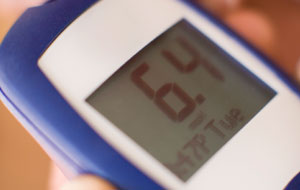Over 30M people in the U.S. have diabetes, and about 95% have type 2 diabetes.* Diabetes is the leading cause of kidney failure, amputation and blindness. It also significantly increases the risk of heart disease and stroke.
Controlling blood sugar is key to living well with diabetes and avoiding serious complications. This means routinely measuring average blood sugar levels (HbA1c) and taking non-insulin and/or insulin medications to maintain a safe range.
Yet, as Mayo Clinic researchers uncovered using OptumLabs data, excessive testing and treatment of patients with diabetes can lead to unexpected harms. These insights have informed new quality measure development for safer, more personalized diabetes care.
Research
Study 1: HbA1c overtesting
For most people with controlled type 2 diabetes, it’s suggested that they have their HbA1c tested 1-2 times per year to guide diabetes therapy. Yet more than half of such patients are tested more frequently than guidelines recommend.
The more doctors test, the more likely they are to add treatments to patient regimens despite their blood sugars already being in a good range. Is this safe?

Study 2: Diabetes overtreatment and hypoglycemia
One in five people with stable type 2 diabetes take too many blood sugar-lowering drugs. In older patients with other health problems, this can almost double their risk for severe hypoglycemia — dangerously low blood sugar that can require hospitalization and even be fatal.
Study 3: Broader implications of diabetes overtreatment
How frequently are people with diabetes overtreated in the general U.S. population and how does that impact health outcomes, particularly hypoglycemia?
More than one in five adults with diabetes whose HbA1c is at goal (less than 7%) are potentially overtreated, with clinically complex patients overtreated at the same rate as those who are younger and healthier.
This has led to nearly 10,000 more emergency department visits and hospitalizations for hypoglycemia in a two-year period than would have occurred if patients were not treated as intensively.
Study 4: Paradoxical trends in diabetes management
While an HbA1C of less than 7% is the target for most people, some people with diabetes receive treatment that is too aggressive or not aggressive enough because treatment is not tailored to their personal circumstances.
Patients who are older and who have multiple and/or advanced comorbidities are at risk for harm (hypoglycemia) if treated intensively. Conversely, younger patients who would benefit from more intensive treatment are sometimes not treated aggressively enough with insulin or multiple medications .
When we work with our patients to develop a diabetes treatment plan, our goal should be to maximize benefit while reducing harm and burden of treatment, taking into account the situation and needs of each individual patient.
– Rozalina McCoy, MD, MS, Principal Investigator, Mayo Clinic
Translation
New diabetes care quality measure development
Today, doctors are rewarded for keeping HbA1c from getting too high by driving for strict glucose control. But when blood sugar gets too low, or when patients who are clinically complex have to use many medications to keep their HbA1c in the desired range, it may also be dangerous.
In collaboration with AARP and OptumLabs, the Mayo Clinic team is pursuing a safer diabetes measure to help doctors find the “sweet spot” for each patient circumstance; considering the benefits and harms of each medication, and aiming for “better” not “lower” blood sugar levels.

Published research insights are disseminated widely and translated to improvements in care quality.
*Centers for Disease Control and Prevention. National Diabetes Statistics Report. Published July 17, 2017. Accessed Sept. 27, 2017.
